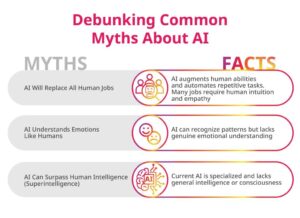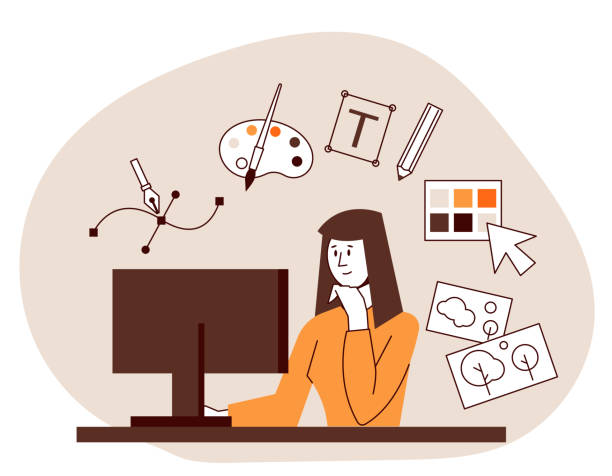Imagine having a partner that can help you brainstorm innovative ideas, streamline your workflow, and bring your most ambitious designs to life. Welcome to the world of AI-powered design, where the boundaries of creativity are being redefined and the possibilities are endless. Artificial intelligence has revolutionized the design industry, empowering creatives to produce stunning visuals, iterate faster, and focus on the aspects of design that truly matter. But, for those who are new to the world of AI, getting started can be daunting. That’s why we’ve created this beginner’s guide to designing with AI, where we’ll demystify the technology, explore its applications, and provide practical tips on how to unlock your creative potential. Whether you’re a seasoned designer looking to stay ahead of the curve or a curious beginner eager to explore the possibilities of AI-powered design, this guide is your key to unlocking a new era of creative expression.
Understanding AI in design: Debunking myths and misconceptions

As we embark on the journey of designing with AI, it’s essential to clarify the misconceptions and myths that surround this innovative technology. Many designers and creatives are hesitant to incorporate AI into their workflow, fearing that it will replace human intuition and creativity. However, the truth is that AI is designed to augment and enhance human capabilities, not replace them. AI can assist with tedious and time-consuming tasks, freeing up designers to focus on the creative aspects of their work. Another common misconception is that AI-generated designs are impersonal and lack character. On the contrary, AI can help designers explore new ideas and styles that they may not have considered before, leading to fresh and innovative designs. The true capabilities and limitations of AI in design, can unlock its full potential and harness its power to revolutionize the creative industry.
What exactly are AI design tools for ecommerce?
Imagine having a creative assistant who can generate stunning visuals, streamline repetitive tasks, and personalize your brand experience. That’s essentially what AI design tools offer. These online platforms use artificial intelligence to automate various design tasks, making professional-looking visuals accessible to everyone, regardless of design experience. Here are some of the key benefits AI design tools offer to ecommerce entrepreneurs:
Effortless product image creation: Generate high-quality product images with features like background removal and model placement, perfect for showcasing your products in a clean and professional manner.
Eye-catching banner & social media graphics design: Create visually appealing social media posts, product banners, and website graphics using pre-designed templates and AI-powered customization options.
Personalized product recommendations: Leverage AI to recommend relevant products to customers based on their browsing history and purchase behavior, increasing conversion rates and customer satisfaction.
A/B testing made easy: Test different design variations, like product layouts and call-to-action buttons, to see what resonates best with your audience, all within the AI platform.
Getting started with AI design tools: A beginner’s guide
It’s essential to keep in mind that the key to unlocking creative potential lies in embracing the possibilities of AI while still maintaining a human touch. To get started, begin by familiarizing yourself with the various AI-powered design tools available, such as generative design software, neural networks, and machine learning algorithms. Experiment with these tools to discover their capabilities and limitations. Next, focus on developing a clear understanding of your design goals and objectives, as this will enable you to effectively communicate with the AI system and guide its output. Additionally, don’t be afraid to push the boundaries of what is possible with AI-driven design. Encourage the AI to generate unexpected and innovative solutions, and then use your human intuition to refine and curate the results. By embracing this collaborative approach, you’ll be able to unlock the full potential of AI-driven design and create truly remarkable and innovative designs. The good news is that you don’t need a design degree to utilize AI design tools. Here’s a step-by-step guide to get you started:
1.Identify your needs: First, consider what design areas you need the most help with. Do you need product mockups, eye-catching social media posts, or a website design revamp? Once you identify your specific needs, you can choose the right AI design tool.
2.Explore free trials & freemium options: Many AI design tools offer free trials or freemium plans, allowing you to experiment with the platform and see if it fits your needs before committing. Popular options include:
-
- Canva: A user-friendly platform with a wide range of templates for social media graphics, presentations, and even basic website creation. Their freemium plan offers a good selection of design elements and features.
- Placeit: Specializes in creating product mockups. Their platform allows you to showcase your products on various templates, like phone cases, apparel, and packaging.
- Snappa: Offers a vast library of pre-designed templates for social media posts, ads, and website banners. Their user-friendly interface makes it easy for beginners to create professional-looking visuals.
3.Leverage templates and tutorials: Most AI design tools offer a plethora of pre-designed templates and tutorials. Utilize these resources to create a foundation for your designs and learn the platform’s basic functionalities.
4.Focus on personalization: While templates are helpful, don’t be afraid to personalize them! Use the AI-powered editing tools to customize colors, fonts, and add your own brand elements to create visuals that reflect your unique brand identity.
5.A/B testing is your friend: Many AI design tools offer built-in A/B testing features. Utilize this function to test different design variations, like product layouts and call-to-action buttons, to see what resonates best with your audience. This data-driven approach helps you optimize your designs for better conversions.
Advanced tips for ecommerce success
As you become more comfortable with AI design tools, consider these advanced tips:
Maintaining brand consistency: Ensure your AI-generated designs align with your overall brand identity. Use consistent color palettes, fonts, and design elements across all your visuals.
High-quality images: While AI can generate product mockups, always strive to use high-quality product photography whenever possible. Professional product photos enhance customer trust and product perception.
Data-driven decisions: Don’t just rely on intuition. Utilize the analytics features offered by many AI design tools to track the performance of your visuals. Use this data to refine your designs and improve their effectiveness.
Human touch matters: Remember, AI is a powerful tool, but it doesn’t replace human creativity. Use AI as a springboard to generate ideas, but add your own creative flair to make your designs truly unique.
Here’s a list of 10 AI design tools for designers, categorized based on their strengths:
Image & Video Creation
- Midjourney (Text-to-Image) https://midjourney.co/
A powerful tool that generates unique and artistic images based on your text descriptions. Great for concept art and creative exploration.
- DALL-E 2 (Text-to-Image) https://openai.com/index/dall-e-2/
Another cutting-edge option with limited access currently. DALL-E 2 excels at generating realistic and photo quality images based on your prompts.
Graphic Design & Mockups
- Canva (Free & Paid Plans) https://www.canva.com/
A user-friendly platform offering a vast library of templates for social media graphics, presentations, and basic website creation. Their freemium plan provides a good selection of design elements for beginners.
- Placeit (Paid Plans) https://placeit.net/
Specializes in creating product mockups. Showcase your products on a variety of templates, including phone cases, apparel, and packaging.
UI/UX Design & Prototyping
- Adobe XD (Free & Paid Plans) https://www.adobe.com/
A comprehensive UI/UX design and prototyping tool from Adobe. While not purely AI-powered, XD offers features like auto-animation and content syncing to streamline the design process.
- Figma (Free & Paid Plans) https://www.figma.com/
A popular web-based design platform with strong collaboration features. Figma offers plugins that integrate AI functionalities for tasks like generating design variations and creating mockups.
AI-Powered Design Assistants
- Autodesk (Free & Paid Plans) https://www.autodesk.com/
An AI-powered design assistant offering various features like image editing, text effects, and video generation.
- Fotor (Free & Paid Plans) https://www.fotor.com/
More than just an editing tool, Fotor uses AI to suggest design elements, layouts, and color palettes based on your image or project.
Design Optimization & Testing
- Unsplash (Free) https://unsplash.com/
While not strictly an AI design tool, Unsplash offers a vast library of high-quality, royalty-free images. Utilize their AI-powered search to find the perfect visuals for your project.
- Maze (Paid Plans) https://maze.co/
A user testing platform that leverages AI to analyze user behavior on your website or app. Gain valuable insights on how users interact with your design and identify areas for improvement.
In conclusion, this journey into the realm of AI-powered design, it’s clear that the possibilities are endless. With the ability to automate repetitive tasks, generate new ideas, and amplify human creativity, AI is revolutionizing the way we approach design. Whether you’re a seasoned designer or just starting out, incorporating AI into your workflow can unlock new levels of creativity, efficiency, and innovation. Embracing this technology, you will tap into a vast potential of artistic expression, pushing the boundaries of what’s possible and bringing your most ambitious projects to life. So, don’t be afraid to experiment, explore, and learn from the AI design tools at your disposal. The future of design is here, and it’s more exciting than ever.

